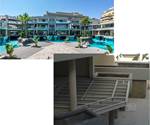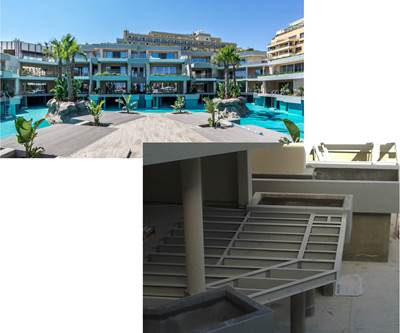Composites in architecture: A hidden opportunity
Many applications in the aerospace and automotive industries apply equally to architecture, such as the use of FRP. Other opportunities for traditional composite materials may lie in seeking out creative applications.

Photo Credit: Getty Images
In late April this year when I wrote my June column, I was hoping for an amelioration of the coronavirus pandemic and aspiring to attend two events “in person” in September — the Society of Plastics Engineers (SPE, Danbury, Conn., U.S.) Automotive Conference and Exhibition (ACCE) and the Composites and Advanced Materials Expo (CAMX). I have attended every edition of each event since they started. Now, September has come and gone, and while both events happened, they were completely virtual. Alas, no driving to Detroit or flying to Orlando this year. Nonetheless, I dedicated many hours to both events, albeit from the comfort of my home office.
While it’s extremely difficult to replicate the excitement of a busy convention hall and the serendipitous moments that come from bumping into longtime acquaintances on the show floor, both events delivered about as well as they could in this environment. The exhibit halls for each event offered the chance to download product information, view recorded video and establish contact with company representatives to schedule a live virtual meeting. I missed the opportunity to see and touch displays, which for me is an integral part of a good trade show experience.
Where these two important events really delivered was in the streaming of live content, including keynotes, featured presentations, panel discussions and technical papers or demonstrations. Both organizing teams did a good job of bringing speakers with great credentials and insights into key markets and applications, and the opportunity to engage in a live chat with other attendees and Q&A for the speakers enhanced my learning experience.
Many of the advantages we promote for applications in automotive and aerospace apply equally for architecture.
I wrote several months ago how I derive inspiration for my column from attending important industry events, and I found plenty of interesting topics to cover in these virtual ones. One featured presentation at CAMX put my creative wheels in motion more than any other: “Composites for Modern Architecture” presented by Dr. Samir Aljishi, president of BFG Architecture, based in Bahrain. While I have certainly been aware of the use of fiber glass-reinforced plastic (FRP) for improving building aesthetics for many years, Dr. Aljishi’s presentation featured several examples I had not seen before. I ran a molding compound plant in the north of France in the mid-1990s, and one of our major customers was an Italian company that purchased UV-resistant polyester bulk molding compound (BMC) for compression molded wall claddings to enhance the exterior appearance and energy efficiency of many buildings in Eastern Europe. These were small, rectangular parts, unlike the curvilinear and exceptionally large-scale (in terms of dimensions) components shown by Dr. Aljishi.
Many of the advantages we promote for applications in automotive and aerospace apply equally for architecture. FRP offers mass reduction of up to 75% versus construction steel and up to 70% versus steel-reinforced concrete. This significantly reduces the downward force on a foundation — one of the structures cited was a 26-meter-diameter FRP dome for a mosque in Bahrain, weighing only 30 tons in FRP, versus 150 tons for the original stone-clad design. In addition to weight savings opportunities, durability is an oft-cited advantage of composites, and the dome and several other FRP structures in the Middle East have existed for more than 30 years without the need for maintenance, even in a hot, desert environment with high UV exposure. The ability to achieve compound curves and replicate the look and feel — smooth or rough, for example — of traditional materials, including stone, brick, concrete, wood, stainless steel, chrome and even gold, cannot be overstated. I’ve bemoaned in the past how we try to make composites look like steel or aluminum in cars and airplanes, using the term “hiding in plain sight” when covered by a layer of paint. It’s still an advantage no other class of materials have.
My youngest son is a third-year architecture student in Michigan and, in my opinion, is highly creative with an eye for design. His exposure to composites has largely come from dropping in on the exhibit floor at the SPE ACCE several times, as he is also a car aficionado. In my son’s courses, the emphasis is on how to creatively use traditional building materials, which presents a wonderful opportunity to expand the material palettes of these students. As an industry, when we think about young people who might become interested in composite materials, we tend to focus on STEM students and university engineering and materials sciences programs. How can we work together to increase the teaching of composite materials in architecture curricula? I believe herein lies a real opportunity to grow the market for composites.
Read Next
Natural gas and hydrogen: A renewed opportunity?
Compressed natural gas (CNG) has been steadily gaining ground, and is proving to be a promising market for composites transportation.
Read MoreFRP profiles enable affordable aesthetic solution for unique residential architecture
The FRP profiles, manufactured by Italy-based M.M. S.r.l., allow easy fabrication and construction on-site in less than two days.
Read More“Structured air” TPS safeguards composite structures
Powered by an 85% air/15% pure polyimide aerogel, Blueshift’s novel material system protects structures during transient thermal events from -200°C to beyond 2400°C for rockets, battery boxes and more.
Read More



















